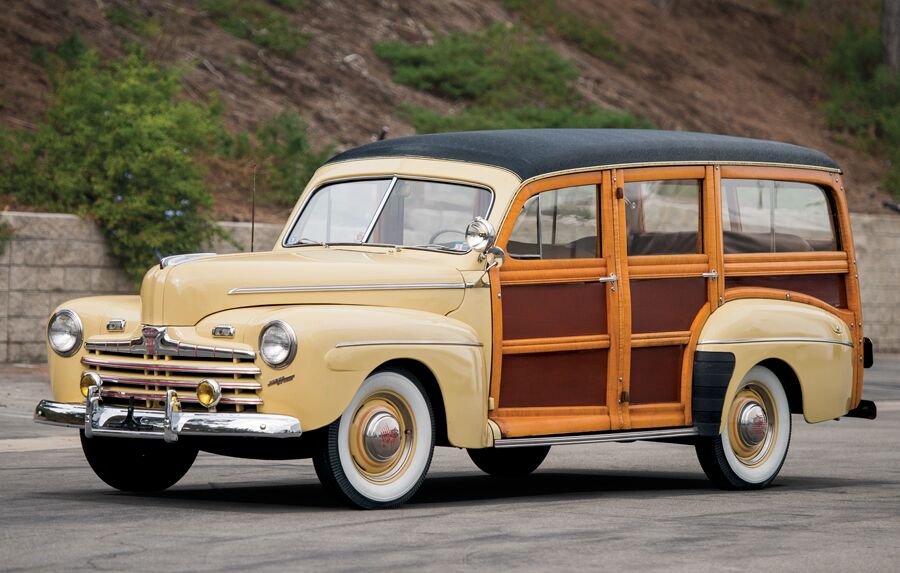SCM Analysis
Detailing
| Vehicle: | 1946 Ford Super DeLuxe Station Wagon |
| Years Produced: | 1946 |
| Number Produced: | 16,920 |
| Original List Price: | $1,422 |
| SCM Valuation: | $68,200 |
| Tune Up Cost: | $300 |
| Chassis Number Location: | Left frame rail |
| Engine Number Location: | Top of bellhousing |
| Club Info: | National Woodie Club |
| Website: | www.nationalwoodieclub.com |
| Alternatives: | 1948 Packard Station Sedan, 1946 Oldsmobile 60 Series station wagon, 1947 Buick Super Estate Wagon |
| Investment Grade: | C |
This car, Lot 119, sold for $62,750, including buyer’s premium, at RM Sotheby’s auction at the Arizona Biltmore in Phoenix, AZ, on January 19, 2018.
Mention a woodie station wagon and your first thoughts are of the iconic Ford wood station wagons built between 1929 and 1951. The pioneer, however, was William C. Durant, who introduced the 1923 Star Station Wagon with a wood body by Mengel. It was intended to compete with the Ford Model T, but it was poorly promoted and quickly became a footnote in automotive history.
The Model T, however, was never offered by Ford as a station wagon or depot hack, but a number of them were certainly sold by Ford dealers. Custom coachbuilders such as Hercules, Cantrell, Martin-Perry and Babcock were doing a brisk business of building wood bodies for the Model T and selling them directly to Ford dealers, who installed them on the bare Ford chassis.
A wooden Ford
Edsel Ford became president of Ford Motor Company in 1919, but Henry still firmly held the reins. Edsel, however, had an eye for design, and the aftermarket wood bodies that Ford dealers were offering were appealing. Murray was supplying metal stampings and even complete bodies to Ford, and Edsel approached them regarding a wood body for the new Model A chassis.
Henry Ford had earlier acquired 313,000 acres of prime timberland in Michigan’s Upper Peninsula as a source of wood for Model T floorboards, framing and even shipping crates. By 1923, Iron Mountain had 7,000 employees working around the clock producing wood parts for the Model T. It was, of course, the ideal source of wood for the new wagon. Mengel shaped and created the parts and Murray assembled the finished wood bodies, which were mated to the chassis at Ford plants.
The first Model A wagon was completed in 1928 and went to “Skylands,” Edsel Ford’s new summer estate at Sea Harbor, ME — the estate is now owned by Martha Stewart. The Ford Depot Wagon was just the thing for the caretaker to drive when meeting “Fairlane,” Edsel’s parlor car, when the train arrived in Maine.
In January 1929, the first Ford wood station wagons were officially announced. Promoted for use at country clubs and estates, the rugged attractiveness and construction proved popular and 6,529 were produced the first two years. They were popular with the Hollywood set, which of course added to their allure.
The in-house solution
The 1940 Deluxe Station Wagon was the first that was built by Ford at the Iron Mountain plant. They were fully integrated, from the harvesting of the timber to loading the finished bodies on the boxcars. Quality was also stated to be greatly enhanced.
The war ended automotive body production but the Iron Mountain plant stayed busy building 80% of the U.S. wood gliders. As the war concluded, Henry Ford II, returning from Navy duty, took the reins at Ford. Station wagons were not high on his list, and he planned on shuttering the outdated Iron Mountain facility. Steel was, however, in short supply but wood was not. So with that, the Ford woodie was back in business and they were quickly snapped up by those who wanted a distinctive vehicle or needed a practical second car.
The 1946 Ford Wagon was offered with a V8 and, later in the model year, a 6-cylinder motor. It was priced at $1,422. Production was a respectable 16,920. A brown leatherette top was specified, but factory photos show that black was also used. Maize Yellow, as our subject wagon was finished, was not listed as a factory body color in 1946 — it was, however, available in 1947 and 1948 on convertibles.
This car’s wood was stated to be original and there were noticeable dark stains around the bolt holes and joints. The roof leatherette had been replaced and properly tacked to the roof frame. The trim piece that covers the tacks over the drip rails was missing. While it is a difficult piece to find, it is a tell that other items may have also been overlooked.
The market has not been kind to Ford woodies as of late. But Ford buyers, to their credit, are a discerning lot, and many of the recent offerings have had significant issues. In this car’s case, the wood needs to be refinished, the body repainted in a factory-correct color (unless it can be proven that this was, in fact, the original hue) and the proper drip-rail trim piece installed, at a minimum. It could, of course, be used as a driver as-is, and if that’s the case, the price paid was about right in today’s market. All in all, call this one a decent deal all around.
(Introductory description courtesy of RM Sotheby’s.)
